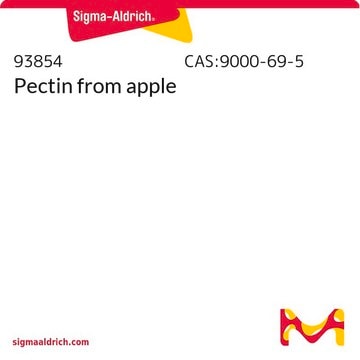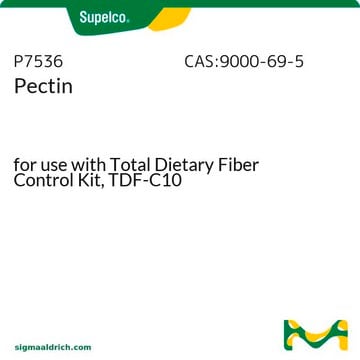P3889
Polygalacturonic acid
≥85% (titration), from oranges
Scegli un formato
Scegli un formato
About This Item
Prodotti consigliati
Origine biologica
oranges
Saggio
≥85% (titration)
Stato
powder
Colore
white to brown
Punto di fusione
60 °C
Solubilità
aqueous NaOH: 1%, clear to hazy
Temperatura di conservazione
room temp
Stringa SMILE
O1[C@@H]([C@@H]([C@H]([C@H]([C@H]1C(=O)O)O)O)O)O
InChI
1S/C6H10O7/c7-1-2(8)4(5(10)11)13-6(12)3(1)9/h1-4,6-9,12H,(H,10,11)/t1-,2+,3+,4-,6-/m0/s1
AEMOLEFTQBMNLQ-BKBMJHBISA-N
Cerchi prodotti simili? Visita Guida al confronto tra prodotti
Descrizione generale
Applicazioni
- in the preabsorption of 2F4 primary antibody solution[3]
- as a substrate to determine polygalacturonase activity[4]
- in the preparation of oligogalacturonates mixture which is used as a substrate to determine the specificities of different acetylesterases[5]
Azioni biochim/fisiol
Altre note
Codice della classe di stoccaggio
11 - Combustible Solids
Classe di pericolosità dell'acqua (WGK)
WGK 3
Punto d’infiammabilità (°F)
Not applicable
Punto d’infiammabilità (°C)
Not applicable
Dispositivi di protezione individuale
Eyeshields, Gloves, type N95 (US)
Scegli una delle versioni più recenti:
Possiedi già questo prodotto?
I documenti relativi ai prodotti acquistati recentemente sono disponibili nell’Archivio dei documenti.
I clienti hanno visto anche
Protocolli
To measure pectinase activity, a titrimetric stop reaction assay is used. One unit of pectinase will liberate 1 μmol of galacturonic acid from poly-galacturonic acid per hour at pH 4.0 at 25 °C.
Filtri attivi
Il team dei nostri ricercatori vanta grande esperienza in tutte le aree della ricerca quali Life Science, scienza dei materiali, sintesi chimica, cromatografia, discipline analitiche, ecc..
Contatta l'Assistenza Tecnica.








